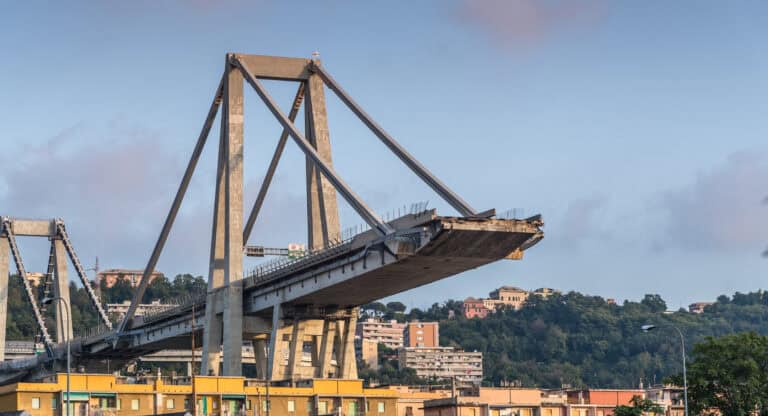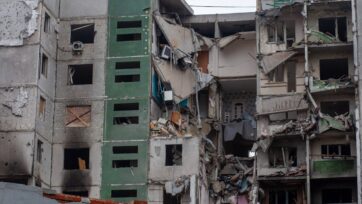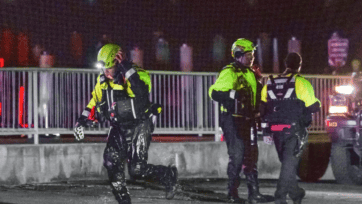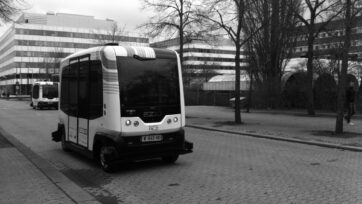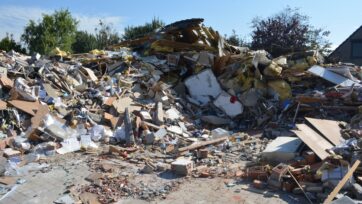On 14 August 2018 during a torrential rainstorm, a 210-meter section of Morandi Bridge in Genoa, Italy collapsed. The Genoa bridge collapse killed 43 people, injured 16 and left 600 homeless. An 80-meter section of the bridge, including one set of the supports that tower above it, crashed down onto the roof of a factory and other buildings, crushing at least one lorry and plunging huge slabs of concrete into the river below.
Perhaps the more alarming fact which emerged from the investigations was the disaster’s foreseeability. It has been revealed that over the last decade, the 1967 Morandi Bridge has been under constant maintenance, with a 2011 report by the Italian highways operator Autostade per l’Italia warning of the structure’s “intense decay.” This was echoed by Giovanni Calvini, leader of Genoa’s business federation, who, in 2012 said that the bridge was at risk of collapse within 10 years, and needed to be replaced. Moreover, local residents had long observed maintenance work on the bridge on a nightly basis, with one telling The New York Times that on the night before the collapse, workers were focused on the portion of the bridge that ultimately collapsed.
The bridge was constructed of pre-stressed, reinforced concrete as opposed to the standard steel design for modern bridges, which allowed it to be stronger and lighter, yet also caused the structure to decay at a rate that was not anticipated by the engineers who created the design. Antonio Brencich, professor of engineering at the University of Genoa, attributed the concrete’s rapid deterioration to the major repairs and replacements needed from the 1990s onwards. As the tie beams linking bridge parts were encased in concrete, a precise analysis of their condition was also never possible, according to Brencich.
Ironically, ahead of the bridge’s opening, an article in La Stampa newspaper boasted that “The bridge’s concrete structure won’t need any maintenance. Neither will its stayed cables, which are protected from atmospheric agents by their concrete vest.” Evidenced in the bridge’s rapid decay and eventual collapse, this calamity is yet another incident that unveiled the tragic ramifications that could arise from even a small case of human negligence in engineering.
What can be done to prevent such incidents?
There were clearly major disconnects in the original engineering assumptions, the ability to monitor and maintain the structure throughout its life, and also the ability of leaders to take seriously the warnings about increasing risk and exposure to catastrophic failure. Sadly, this combination of circumstances can be seen over and over again in development efforts across all industries and regions of the world.
Research by Carnegie Mellon University SEI, IEEE and the NDIA show correlation coefficients between systems engineering practices and project performance (quality, cost and schedule) averaging +0.3 for technical projects in general and +0.6 for the more complex projects. Not only does it capture stakeholder needs and objectives and transform these into a description of a holistic, life cycle balanced system solution, but systems engineering also incorporates both technical and management processes. It is a powerful tool for identifying, managing and controlling the potential risk factors in the entirety of the project life cycle.
References
Mattioli, G 2019, What caused the Genoa bridge collapse – and the end of an Italian national myth?, viewed 27 January 2021, https://www.theguardian.com/cities/2019/feb/26/what-caused-the-genoa-morandi-bridge-collapse-and-the-end-of-an-italian-national-myth
Walsh, N 2018, The Deadly Genoa Bridge Collapse was Predicted, and Avoidable, viewed 27 January 2021, https://www.archdaily.com/900260/the-deadly-genoa-bridge-collapse-was-predicted-and-avoidable
